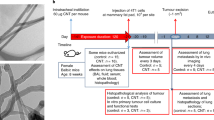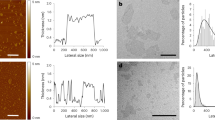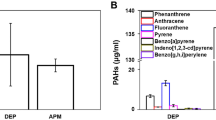Abstract
Carbon nanotubes are shaped like fibres1 and can stimulate inflammation at the surface of the peritoneum when injected into the abdominal cavity of mice2, raising concerns that inhaled nanotubes3 may cause pleural fibrosis and/or mesothelioma4. Here, we show that multiwalled carbon nanotubes reach the subpleura in mice after a single inhalation exposure of 30 mg m−3 for 6 h. Nanotubes were embedded in the subpleural wall and within subpleural macrophages. Mononuclear cell aggregates on the pleural surface increased in number and size after 1 day and nanotube-containing macrophages were observed within these foci. Subpleural fibrosis unique to this form of nanotubes increased after 2 and 6 weeks following inhalation. None of these effects was seen in mice that inhaled carbon black nanoparticles or a lower dose of nanotubes (1 mg m−3). This work suggests that minimizing inhalation of nanotubes during handling is prudent until further long-term assessments are conducted.
This is a preview of subscription content, access via your institution
Access options
Subscribe to this journal
Receive 12 print issues and online access
$259.00 per year
only $21.58 per issue
Buy this article
- Purchase on Springer Link
- Instant access to full article PDF
Prices may be subject to local taxes which are calculated during checkout




Similar content being viewed by others
References
Donaldson, K. et al. Carbon nanotubes: a review of their properties in relation to pulmonary toxicology and workplace safety. Toxicol. Sci. 92, 5–22 (2006).
Poland C. A. et al. Carbon nanotubes introduced into the abdominal cavity of mice show asbestos-like pathogenicity in a pilot study. Nature Nanotech. 3, 423–428 (2008).
Ryman-Rasmussen, J. P. et al. Inhaled multiwalled carbon nanotubes potentiate airway fibrosis in a murine model of allergic asthma. Am. J. Resp. Cell. Mol. Biol. 40, 349–358 (2009).
Mossman, B. T. & Churg, A. Mechanisms in the pathogenesis of asbestosis and silicosis. Am. J. Resp. Crit. Care Med. 157, 1666–1680 (1998).
Card, J. W., Zeldin, D. C., Bonner, J. C. & Nestman, E. R. Pulmonary applications and toxicity of engineered nanoparticles. Am. J. Physiol. 295, L400–L411 (2008).
Muller, J. et al. Respiratory toxicity of multi-wall carbon nanotubes. Toxicol. Appl. Pharmacol. 207, 221–231 (2005).
Lam, C. W., James, J. T., McCluskey, R. & Hunter, R. L. Pulmonary toxicity of single-wall carbon nanotubes in mice 7 and 90 days after intratracheal instillation. Toxicol. Sci. 77, 126–134 (2004).
Warheit, D. B. et al. Comparative pulmonary toxicity assessment of single-wall carbon nanotubes in rats. Toxicol. Sci. 77, 117–125 (2004).
Mercer, R. R. et al. Alteration of deposition pattern and pulmonary response as a result of improved dispersion of aspirated single-walled carbon nanotubes in a mouse model. Am. J. Physiol. 294, L87–L97 (2008).
Shvedova, A. A. et al. Unusual inflammatory and fibrogenic pulmonary responses to single-walled carbon nanotubes in mice. Am. J. Physiol. 289, L698–L708 (2005).
Miller, F. J. Dosimetry of particles in laboratory animals and humans in relationship to issues surrounding lung overload and human health risk assessment: a critical review. Inhal. Toxicol. 12, 19–57 (2000).
Mitchell, L. A. et al. Pulmonary and systemic immune response to inhaled multiwalled carbon nanotubes. Toxicol. Sci. 100, 203–214 (2007).
Li, J. G. et al. Comparative study of pathological lesions induced by multiwalled carbon nanotubes in lungs of mice by intratracheal instillation and inhalation. Environ. Toxicol. 22, 415–421 (2007).
Ogami, A. et al. Pathological features of different sizes of nickel oxide following intratracheal instillation in rats. Inhal. Toxicol. 19, 1–7 (2009).
Takagi, A. et al. Induction of mesothelioma in p53 + /- mouse by intraperitoneal application of multi-wall carbon nanotube. J. Toxicol. Sci. 33, 105–116 (2008).
Brody, A. R., Hill, L. H., Adkins, B. Jr & O'Connor, R. W. Chrysotile asbestos inhalation in rats: deposition pattern and reaction of alveolar epithelium and pulmonary macrophages. Am. Rev. Respir. Dis. 123, 670–679 (1981).
Choe, N. et al. Pleural macrophage recruitment and activation in asbestos-induced pleural injury. Environ. Health Perspect. 105, 1257–1260 (1997).
Coin, P. G., Roggli, V. L. & Brody, A. R. Persistence of long, thin chrysotile asbestos fibers in the lungs of rats. Environ. Health Perspect. 5, 197–199 (1994).
Kane, A. Animal models of malignant mesothelioma. Inhal. Toxicol. 18, 1001–1004 (2006).
Mangum, J. B. et al. Single-walled carbon nanotube (SWCNT)-induced interstitial fibrosis in the lungs of rats is associated with increased levels of PDGF mRNA and the formation of unique intercellular carbon structures that bridge alveolar macrophages in situ. Part. Fibre Toxicol. 3, 15 (2006).
Bonner, J. C. Regulation of PDGF and its receptors in fibrotic diseases. Cytokine Growth Factor Rev. 15, 255–273 (2004).
Walker, C. et al. Characterization of platelet-derived growth factor and platelet-derived growth factor receptor expression in asbestos-induced rat mesothelioma. Cancer Res. 52, 301–306 (1992).
Mishra, A., Liu, J. Y., Brody, A. R. & Morris, G. F. Inhaled asbestos fibers induce p53 expression in the rat lung. Am. J. Respir. Cell. Mol. Biol. 16, 479–485 (1997).
Zhu, L., Chang, D. W., Dai, L. & Hong, Y. DNA damage induced by multiwalled carbon nanotubes in mouse embryonic stem cells. Nano Lett. 7, 3592–3597 (2007).
Elgrabli, D. et al. Biodistribution and clearance of instilled carbon nanotubes in rat lung. Part. Fibre Toxicol. 5, 20 (2008).
Maynard, A. D. et al. Exposure to carbon nanotube material: aerosol release during the handling of unrefined single-walled carbon nanotube material. J. Toxicol. Environ. Health A 67, 87–107 (2004).
Acknowledgements
This study was funded by the American Chemistry Council's Long Range Research Initiative provided to The Hamner Institutes for Health Sciences, The National Institutes of Environmental Health Sciences grant no. R21-ES015801-01, North Carolina State University College of Agricultural and Life Sciences, and the Intramural Research Program of the National Institutes of Health, National Institute of Environmental Health Sciences. ACS/LRRI provided funds only and played no role in study design, data gathering and interpretation, authoring of the manuscript, or decision to publish. Special thanks go to Betsy Gross-Bermudez and the pathology staff at The Hamner Institutes for excellent technical assistance, and to A. Taylor at NCSU for critical reading of the manuscript.
Author information
Authors and Affiliations
Contributions
J.P.R. and J.C.B. initiated, directed and performed all experiments and took responsibility for planning and writing the manuscript. J.P.R., M.E.A., B.A.W., O.M. and J.C.B designed the inhalation exposure experiment. B.W. and E.W.T. designed the inhalation exposure apparatus and performed testing for dosimetery. M.F.C., A.R.B., J.E. and J.C.B. evaluated pathology for identification and verification of pleural lesion identity. J.K.S. performed electron microscopy for identification of nanotubes in lung tissue. A.R.B. and M.E.A. provided intellectual support on mesothelioma and risk assessement.
Corresponding author
Supplementary information
Supplementary information
Supplementary information (PDF 1120 kb)
Rights and permissions
About this article
Cite this article
Ryman-Rasmussen, J., Cesta, M., Brody, A. et al. Inhaled carbon nanotubes reach the subpleural tissue in mice. Nature Nanotech 4, 747–751 (2009). https://doi.org/10.1038/nnano.2009.305
Received:
Accepted:
Published:
Issue Date:
DOI: https://doi.org/10.1038/nnano.2009.305
This article is cited by
-
Nanosensor detection of reactive oxygen and nitrogen species leakage in frustrated phagocytosis of nanofibres
Nature Nanotechnology (2024)
-
Lung recovery from DNA damage induced by graphene oxide is dependent on size, dose and inflammation profile
Particle and Fibre Toxicology (2022)
-
Biomarkers of nanomaterials hazard from multi-layer data
Nature Communications (2022)
-
The ancillary effects of nanoparticles and their implications for nanomedicine
Nature Nanotechnology (2021)



